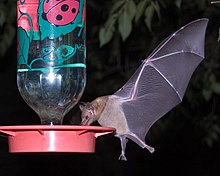Long-nosed bat
| Long-nosed bat | ||||||||||||
|---|---|---|---|---|---|---|---|---|---|---|---|---|

Long-nosed bat |
||||||||||||
| Systematics | ||||||||||||
|
||||||||||||
| Scientific name of the genus | ||||||||||||
| Choeronycteris | ||||||||||||
| Tschudi , 1844 | ||||||||||||
| Scientific name of the species | ||||||||||||
| Choeronycteris mexicana | ||||||||||||
| Tschudi , 1844 |
The long-nosed bat ( Choeronycteris mexicana ) is a species of bat from the leaf-nosed family (Phyllostomidae), which is native to Central America. It is the only species in its genus.
The generic name is a combination of the Greek words choiros (pig) and nykteris (bat). The species name refers to the main distribution area Mexico .
description
The long-nosed bat is a medium-sized bat that weighs 10 to 20 g. The fur is grayish-brown, with the belly lighter than the back. The ears are a light gray, while the flight skin is dark gray with slightly lighter tips. Like all representatives of the flower bats it also has an elongated snout and like most representatives of the leaf noses a conspicuous nasal blade , which is 5 mm long in this species. The upper incisors are tiny and separated by a gap, while the lower incisors are completely absent. This allows the bat to stick its tongue out through a kind of channel. The edges and the tip of the tongue are provided with bristle-like papillae. These make it easier for the bat to absorb nectar from calyxes. At 77 mm, the long-nosed bat's tongue is one of the longest among bats.
Way of life
The habitat of the long-nosed bat extends from dry scrubland to tropical forests. Like most bats, this species is nocturnal. It feeds mainly on nectar and pollen, but also eats fruits and insects.
The long-nosed bat is an important pollinator of various cactus species, as well as the agave . In addition, the species contributes significantly to the spread of cactus seeds.
During the day, the long-nosed bat hangs in dimly lit areas of caves and abandoned mines. Unusually for bats, the animals keep an individual distance of 2 to 5 cm from one another within the groups. Long-nosed bats usually hang from the ceiling with only one foot so that they can turn up to 360 ° and see intruders quickly. The animals are considered to be very vigilant and can be easily disturbed.
distribution
The distribution of the long-nosed bat extends from southern Arizona via Mexico and Guatemala to Honduras . Its population is classified as potentially endangered by the IUCN , as the species is likely to depend on agaves and the populations have declined by 30% in recent years.
literature
- J. Arroyo-Cabrales, R. Hollander, J. Knox Jones (1987): Choeronycteris mexicana , Mammalian Species, No. 291, pp. 1-5
Web links
swell
- ^ Y. Winter, O. von Helversen (2003): Operational tongue length in phyllostomid nectar-feeding bats. Journal of Mammalogy 84, pp. 886-896
- ↑ A. Valiente-Banuet, MD Arizmendi, A. Rojas-Martinez, L. Dominguez Canseco (1996): Ecological relationships between columnar cacti and nectar-feeding bats in Mexico. Journal of Tropical Ecology 12, pp. 103-119
- ↑ PE Scott (2004): Timing of Agave palmeri flowering and nectar-feeding bat visitation in the peloncillos and Chiricahua mountains. Southwestern Naturalist 49, pp. 425-434.
- ↑ H. Godinez-Alvarez, A. Baliente-Banuet (2000): Fruit-feeding behavior of the bats Leptonycteris curasoae and Choeronycteris mexicana in flight cage experiments: Consequences for dispersal of columnar cactus seeds. Biotropica 32, pp. 552-556
- ↑ Choeronycteris mexicana in the IUCN Red List of Threatened Species .

